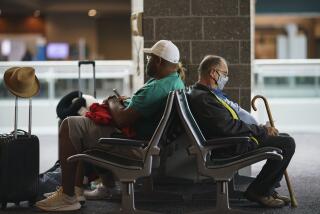Safe Journeys With Diabetes
- Share via
Claudia Graham prefers to spend her vacations kayaking in Hawaii, backpacking in the Himalayas and trekking in Nepal. The fact that she’s insulin-dependent doesn’t slow her down a bit.
Her motto: “Plan for the worst,” says Graham, director of the Diabetes Management Center at Presbyterian Intercommunity Hospital, Whittier. Being prepared for the unexpected can only improve the trip, she says.
Travelers with diabetes, Graham and other experts believe, should be free from restrictions, provided they have their doctor’s approval.
Diabetics tend to worry too much about travel problems, says Dr. Frederick Ziel, director of the Diabetes Center at Kaiser Permanente, Woodland Hills. The majority, he said, can travel without problems--if they pay attention to practical matters such as blood glucose levels.
“Long trips are not much different than going for a Sunday drive to visit friends,” says Maury Rosenbaum, publisher of the Diabetic Traveler, a quarterly newsletter based in Stamford, Conn., and an insulin-dependent diabetic. It’s about being prepared, he says, both mentally and on a practical level.
Those with insulin-dependent diabetes, of course, probably face the most obstacles on trips, Graham says. Most important, she advises these patients, is to take along more than enough syringes, insulin and other necessities for the entire trip and not to assume extras will be available at the destination.
Diabetics should keep their insulin supplies or pills with them, Ziel says. Don’t check them with luggage, which could be lost or delayed.
Graham also recommends leaving an extra pack of supplies at home or with a friend. “If something happens, you can just call home and have them sent,” says Graham, who once did that.
Anti-nausea medicines--the type available only by prescription--are another necessity. Taking them when nausea strikes can help hold down food and insulin or medicine, Graham says. While climbing Mt. Whitney, Graham suffered nighttime altitude sickness, but her anti-nausea medicine helped her make it through until she could descend in the morning.
In preparation for a trip, paying attention to routine care, such as blood glucose monitoring, can also make travel easier. By knowing what blood sugar levels are normal at specific times of day, she explained, travelers can gauge what effect or how much of an effect travel is having.
Pack the home physician’s telephone number and, if possible, the names and numbers of diabetes specialists at the travel destination, Ziel says. He often fields telephone calls from traveling patients, advising them quickly by phone on diet and insulin questions.
Adjusting insulin is a concern for travelers crossing time zones. “If one travels through more than six time zones, it is essential to speak with your doctor about specific instructions,” he says.
Among other ways to ease travel:
* Wear a medical identification bracelet indicating that you have diabetes.
* Solo travelers should consider telling an airline representative, such as a flight attendant, that they have diabetes.
* When traveling overseas, take along a doctor’s note explaining the need for pills or insulin and syringes. This can ease potential problems with customs officials, Ziel says.
* Make arrangements for storage of insulin if the destination is hot and air-conditioning is not available, says Davida Kruger, a nurse and diabetes educator at Henry Ford Hospital, Detroit.
* “Always carry something to treat low blood sugar,” Kruger says, such as glucose tablets, small hard candies or juice. “Pack enough food to make at least one meal,”
* “When ordering a soft drink on the airlines, ask for the can,” Kruger added. “Then look to be sure it’s sugar-free.”
* Research a foreign country’s cuisine in advance of a trip. Graham once was offered a Tibetan tea that she knew was laced with sugar and butter.
For more information, call the American Diabetes Assn., California affiliate, (800) 828-8293.
The Healthy Traveler appears the second and fourth week of every month.
More to Read
Sign up for The Wild
We’ll help you find the best places to hike, bike and run, as well as the perfect silent spots for meditation and yoga.
You may occasionally receive promotional content from the Los Angeles Times.






